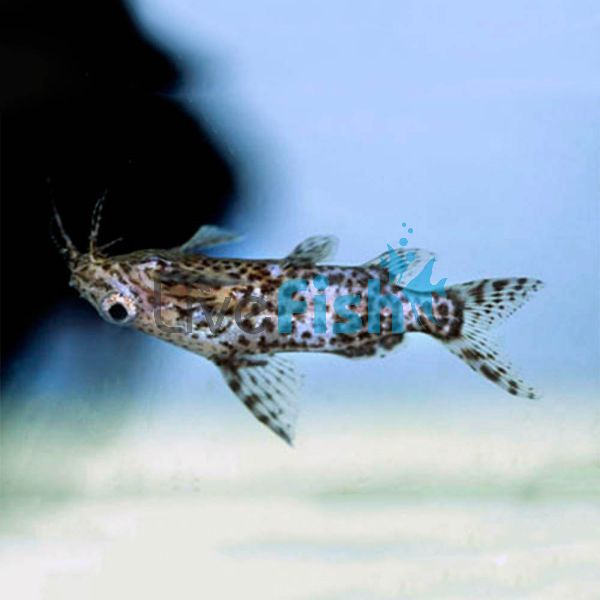Upside Down Catfish 3.5cm
Upside catfish are incredibly odd-looking fish. Their patterning of colours, body shape, and swimming pattern, honestly makes them confusing. When they swim the right way up, these fish look like mini sharks due to the high and pointed dorsal fin. The body colour of these fish is an almost alien-looking purple colour that has highlights of blue iridescence, this is contrasted with an array of black mottling that runs from head to tail. Upside-down catfish have comically large eyes, it’s one of the first things you’ll notice about these fish and it’ll look even weirder because the eyes look so low down on the body but that’s when you realize the fish is swimming upside down. Whilst upside-down catfish spend almost 95% of their time swimming on the wrong side they will occasionally flip over and it will provide hours of fun to just watch these fish.
- Buy 10 for $35.22 each and save 5%
- Buy 20 for $33.36 each and save 10%
Upside Down Catfish
Imagine a fish that spends its whole life swimming upside down and eating like that is completely normal, well that is exactly what the upside-down catfish does. This species that originates from Africa is a part of the synodontis group of catfish that is incredibly popular in the aquarium trade. Upside-down catfish are great oddball entry-level catfish because they are relatively easy to care for, stay quite small, and can perfectly be kept in a species-only tank.
Upside catfish are incredibly odd-looking fish. Their patterning of colours, body shape, and swimming pattern, honestly makes them confusing. When they swim the right way up, these fish look like mini sharks due to the high and pointed dorsal fin. The body colour of these fish is an almost alien-looking purple colour that has highlights of blue iridescence, this is contrasted with an array of black mottling that runs from head to tail. Upside-down catfish have comically large eyes, it’s one of the first things you’ll notice about these fish and it’ll look even weirder because the eyes look so low down on the body but that’s when you realize the fish is swimming upside down. Whilst upside-down catfish spend almost 95% of their time swimming on the wrong side they will occasionally flip over and it will provide hours of fun to just watch these fish.
Upside-down catfish are not bred readily in the home aquarium. It is believed that these are migratory species in the wild and require specific environmental conditions to induce spawning. Aquarists have had luck breeding these fish in certain situations by setting up a similar setup to breeding plecos. Offering a range of caves, giving a protein-rich diet, and creating temperature fluctuations via water changes can help induce spawning.
Tank Recommendations for your Upside Down Catfish
As upside-down catfish are a small but active species that can reach around 9cm it is best to keep them in a tank of 70 liters or more. These are also schooling catfish often found in huge numbers in the wild, keeping a group of 6 or more will really make these fish comfortable. These fish will not be too fussed with the aquarium setting but keeping them on a sandy substrate with some caves and river rocks would make for a great environment. These species can also tolerate a lower PH compared to other synodontis catfish which makes them very versatile to keep.
Suitable Tank Buddies
Synodontis catfish are an incredibly peaceful fish that can be kept in an absolutely massive range of community aquariums. They do not display any aggression and their small mouth means they do not predate that easily on small fish. Synodontis are actually egg eaters so they will actually scavenge on eggs in the wild often laid by African cichlids.
Usually Compatible
community fish such as rams, larger tetras, angelfish, peaceful cichlids, rainbow fish, and many more.
Sometimes Compatible
Larger peaceful South American cichlids such as Uaru, Severums, and other fish may outcompete the catfish as they are mostly bottom-dwelling and small fish.
Rarely Compatible
Large and aggressive species such as Oscars may prey on the catfish. This is especially important as these catfish have spines on their pectoral, this can result in both the upside-down catfish’s and the predator fish’s death.
Feeding your Upside Down
Upside-down catfish are very easy to feed. They will take a wide range of pellets, flakes, and frozen foods. Just like any fish though they should be fed a varied diet with a mix of different foods. The ideal diet would be a good quality micro slow-sinking pellet or crushed flake, supplemented with frozen bloodworms or even live foods like baby brine shrimp or micro worms.
| Scientific Name | Synodontis Nigriventris |
|---|---|
| Care Level | Easy |
| Common Names | Upside down catfish, upside down synodontis |
| Diet | Carnivore |
| Fish Family | Mochokidae |
| Lifespan (years) | 10 |
| Max. Length (cm) | 9 |
| Min. Tank Volume (l) | 70 Liters |
| Origin | African |
| Reef Safe | Yes |
| Sociability | Peaceful |
| Venomous | No |
| Water Conditions | 24-26° C, pH 6.0-7.0 |




